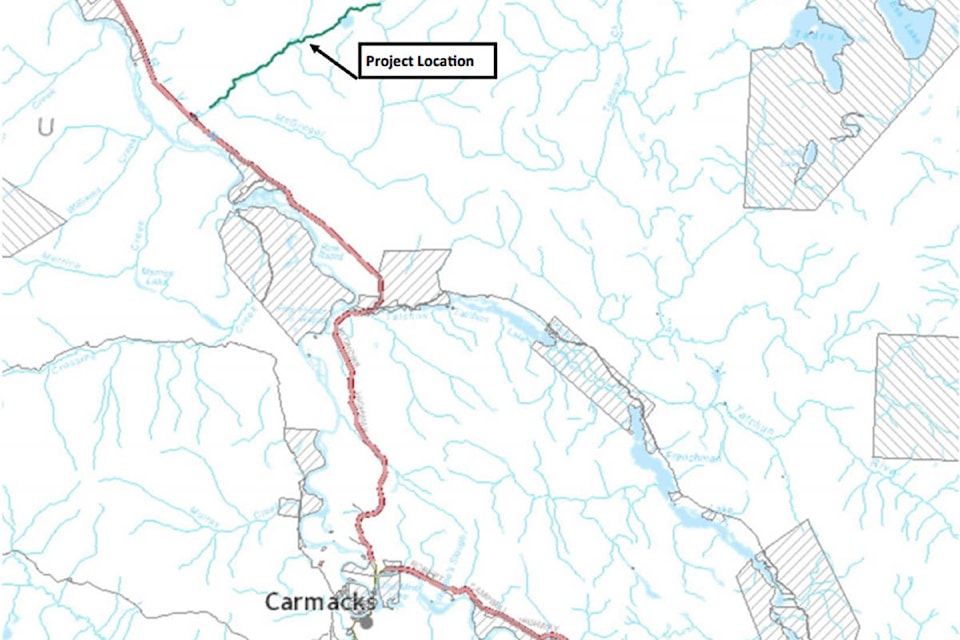The Yukon government doesn’t know yet how much it’s going to cost to reclaim an illegal 17-kilometre road north of Carmacks.
The minister of energy, mines and resources said the government is considering changes to increase the penalties under the Territorial Lands (Yukon) Act.
A Yukon placer miner and a local contractor were fined $1,200 each in 2017 for violating three section of the Lands Act when they built the McGregor Creek access road.
“This is just short of the maximum fine for this kind of offence, which had been set at a staggering $1,500,” NDP Leader Liz Hanson said in the legislative assembly April 3.
“A Crown prosecutor described the offence as ‘one of the worst offences Yukon has seen in terms of contraventions of land use in recent years.’ Does the minister believe that a $1,200 fine for building a 17-kilometre illegal road is proportional to the damages done?”
Minister Ranj Pillai said the territorial government is working with Little Salmon Carmacks First Nation and Selkirk First Nation to develop reclamation and deactivation plans for the illegal McGregor Creek access road.
Some of that planning is being delayed until the snow melts, he said.
Answering follow-up questions, Pillai said there have been discussions with First Nations and industry to try and curb situations like this.
“We are considering legislative changes to increase the penalties under the Territorial Lands (Yukon) Act. I believe that lands act is specifically one of the oldest lands acts in Canada. This would discourage these types of illegal activities,” he said.
“We’re also looking at having the guilty party be held responsible for remediation of the environmental damages caused by unauthorized work.”
Pillai didn’t go into detail regarding what specific changes are being considered or how the guilty parties might be held responsible for the remediation work.
As it stands, the two $1,200 fines paid by miner Nicolai Goeppel and contractor H. Coyne & Sons Ltd. were not specifically earmarked for remediation work. The fine goes into the government’s general revenue, said Colin McDowell, director of the territory’s land management branch.
The reclamation project is currently going through the Yukon’s environmental assessment process.
Recommendations will come out of that process regarding how the road needs to be remediated, McDowell said.
“The recommendations will have an impact on what the scope and scale of the work is and therefore on the cost.”
McDowell said there are three or four stream crossings that are of particular concern.
“We may be required to up the level of effort and intensity around reclaiming those stream crossings, or not, depending on what YESAB comes out with.”
McDowell said the decision was made to reclaim the area after getting complaints including from both First Nations about the impact of the illegal construction on their traditional activities. There is a trapline in the area, he said.
“It’s totally unacceptable for anyone to assume they can go and cross a First Nation site, plow over a trapper trail … and to haul equipment without having any authority to do any such work on that piece of land by EMR (the Department of Energy, Mines and Resources) or the lands department,” LSCFN Chief Eric Fairclough told the News in 2016.
“This mining outfit … I know they know better.”
For his part, Goeppel maintained that he misunderstood the regulations.
McDowell said the reclamation process is expected to take years.
“We would anticipate being in the field both this summer, hopefully, and also next summer,” he said.
“Then we would likely be going into a monitoring phase of a year or two or three to see how well the project is taking off in terms of plants growing and that sort of thing.”
The government has put up a gate blocking access to the illegal road. An administrative reserve has also been placed around the perimeter of the road, he said.
That “prevents any land use permits or that sort of thing being issued over the course of the time that this remediation occurs.”
In the legislative assembly Hanson said 250 mineral claims were staked in a newly accessible area.
“Some of those claims are in the name of those who illegally built the road,” she said.
Contact Ashley Joannou at ashleyj@yukon-news.com
